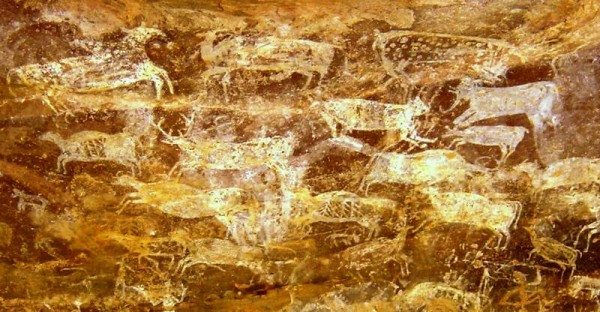Ancient Auditory Illusions Allegedly Reflected in Prehistoric Art
| Marc Maligalig | | Oct 29, 2014 04:26 PM EDT |
(Photo : S. Waller)
Steven J. Waller, from Rock Art Acoustics, will describe a number of ways virtual sound images and absorbers that could have appeared "supernatural" to the ancestors of humans, which could have possible inspired their creation of mysterious artistic works, at the 168th Meeting of Acoustical Society of America to be held on Oct. 27 through Oct. 31 at the Indianapolis Marriott Downtown Hotel.
Like Us on Facebook
"Ancient mythology explained echoes from the mouths of caves as replies from spirits, so our ancestors may have made cave paintings in response to these echoes and their belief that echo spirits inhabited rocky places such as caves or canyons," explained Waller.
Similar to the way light reflects and offers an illusion of seeing one's self copied in a mirror, sound waves that reflect off a surface are identical mathematically to the sound waves that come from virtual sound sources behind a reflecting plane, such as the face of a large cliff.
"This can result in an auditory illusion of somebody answering you from within the rock," Waller said.
While hoof beats may sound similar to the echoes of clapping hands, several echoes inside a cave can mesh together into a reverberation so thunderous that could possibly mimic the sound of hoofed animals stampeding, Waller pointed out.
"Many ancient cultures attributed thunder in the sky to 'hoofed thunder gods,' so it makes sense that the reverberation within the caves was interpreted as thunder and inspired paintings of those same hoofed thunder gods on cave walls," said Waller. "This theory is supported by acoustic measurements, which show statistically significant correspondence between the rock art sites and locations with the strongest sound reflection."
Ancient cultures may have also misinterpreted other acoustical characteristics as they were unaware of the theory of sound waves. Waller observed a resemblance between Stonehenge and an interference pattern, so he put up such a pattern in an open area with two flutes "droning the same note" to find what would it sound like.
"The quiet regions of destructive sound wave cancellation, in which the high pressure from one flute cancelled the low pressure from the other flute, gave blindfolded subjects the illusion of a giant ring of rocks or 'pillars' casting acoustic shadows," Waller said.
After traveling to England, he demonstrated that the landmark does actually radiate acoustic shadows that resemble the similar pattern of interference.
"My theory that musical interference patterns served as blueprints for megalithic stone circles - many of which are called Pipers' Stones - is supported by ancient legends of two magic pipers who enticed maidens to dance in a circle and turned them all into stones," Waller noted.
TagsSound, Prehistoric art, art, Rock Art Acoustics, Supernatural, Ancient cultures, Ancient people, ancestors, Stonehenge, Stampede
©2015 Chinatopix All rights reserved. Do not reproduce without permission
EDITOR'S PICKS
-

Did the Trump administration just announce plans for a trade war with ‘hostile’ China and Russia?
-

US Senate passes Taiwan travel bill slammed by China
-

As Yan Sihong’s family grieves, here are other Chinese students who went missing abroad. Some have never been found
-

Beijing blasts Western critics who ‘smear China’ with the term sharp power
-

China Envoy Seeks to Defuse Tensions With U.S. as a Trade War Brews
-

Singapore's Deputy PM Provides Bitcoin Vote of Confidence Amid China's Blanket Bans
-

China warns investors over risks in overseas virtual currency trading
-

Chinese government most trustworthy: survey
-

Kashima Antlers On Course For Back-To-Back Titles
MOST POPULAR
LATEST NEWS
Zhou Yongkang: China's Former Security Chief Sentenced to Life in Prison

China's former Chief of the Ministry of Public Security, Zhou Yongkang, has been given a life sentence after he was found guilty of abusing his office, bribery and deliberately ... Full Article
TRENDING STORY

China Pork Prices Expected to Stabilize As The Supplies Recover

Elephone P9000 Smartphone is now on Sale on Amazon India

There's a Big Chance Cliffhangers Won't Still Be Resolved When Grey's Anatomy Season 13 Returns

Supreme Court Ruled on Samsung vs Apple Dispute for Patent Infringement

Microsoft Surface Pro 5 Rumors and Release Date: What is the Latest?










